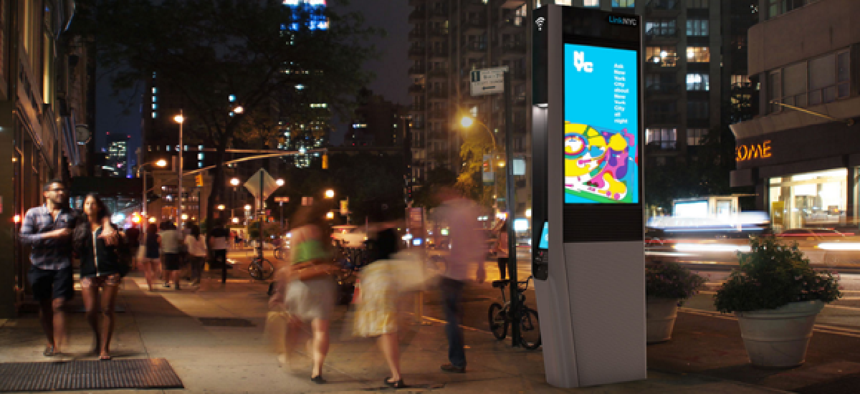Free, high-speed Wi-Fi hotspots launch in NYC


Connecting state and local government leaders
The LinkNYC project intends to install 7,500 Link kiosks across the five boroughs by 2020 that will provide gigabit Wi-Fi, charging stations and web access through a built-in tablet.
The first of New York City’s LinkNYC kiosks went live for beta testing Jan. 19, marking the city’s first step in its plans to provide free, high-speed Wi-Fi.
LinkNYC aims to create a communications network with its 7,500 Link stations that will be erected across the five boroughs by 2020, with 500 being installed by this summer.
The beta phase begins a handful of operational kiosks, each of which will allow users within 150 feet to connect to the LinkNYC gigabit Wi-Fi network. The kiosks are powered by an all-new, purpose-built fiber optic network that will deliver speeds up to 100 times faster than average public Wi-Fi, LinkNYC said.
CityBridge, the consortium of technology firms building LinkNYC, is investing more than $200 million to install hundreds of miles of new fiber optic cable that will deliver gigabit connectivity to Links stations.
An Engadget writer who tested the service shortly after it became operations said he was getting 300 megabit/sec Wi-Fi access, much faster speeds than are typically available in coffee shops and most residences.
The kiosks will contain a built-in tablet allowing users to browse the web and access city services, maps, directions and a 911 emergency call button. People can charge their mobile devices through USB ports, and using the Vonage app on the tablet, can make free phone calls anywhere in the United States, including to 311, 411 and 911. Links kiosks also have two 55” high-definition digital screens used for public service announcements and advertising, which helps fund the stations.
Additional apps and services will be rolled out over the next few months, according to the LinkNYC FAQ.
LinkNYC has two networks: LinkNYC Free Wi-Fi and LinkNYC Private. The open network relies on web server-based SSL security to protect the information passing between a device and the Link. The private network secures all wireless communications between devices and the Link, regardless of whether a website uses SSL security, the FAQ explained. During the beta phase, the private network requires an iOS device and Hotspot 2.0 technology that lets a device verify the authenticity of the ‘LinkNYC Private’ network. The network is one of the first in the country to offer an encrypted public network at this scale, according to a post by Intersection on Medium.
Even so, as the kiosks will be used to browse the web via public Wi-Fi, some are concerned that they pose security risks.
Hackers can “break into them and put information on them to use as a keylogger” to collect passwords, said Tyler Cohen Wood, a cybersecurity adviser to Inspired eLearning. “If you’re on the public network and sending sensitive information, you’re on a network with potentially hundreds other people [who] have the ability to really see what you’re doing.”
To keep the Link stations secure, CityBridge will install cyber protections, including a series of filters and proxies to block anyone who tries to download malware during a browsing session, The Verge reported.
The city will also monitor traffic to stop users from receiving data from a command-and-control server. And if malware is installed on a LinkNYC tablet, it would soon be deleted. The devices go through a hard reset after 15 seconds of inactivity, according to The Verge’s report.
For those who are still uneasy about the security on public networks, Cohen Wood suggested they being wary supplying email addresses or other personal information to access hotspots.




